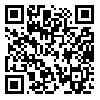Tue, Dec 16, 2025
Volume 9, Issue 2 (6-2020)
2020, 9(2): 19-23 |
Back to browse issues page
Download citation:
BibTeX | RIS | EndNote | Medlars | ProCite | Reference Manager | RefWorks
Send citation to:



BibTeX | RIS | EndNote | Medlars | ProCite | Reference Manager | RefWorks
Send citation to:
Anbari F, Hadadi Madiseh P, Cheraghi Lohe Sara M, Afraz E S. Research Paper: Evaluation of Frequency, Knowledge and Practice of Needle Stick Injuries among Dentists in Iran. Journal title 2020; 9 (2) :19-23
URL: http://3dj.gums.ac.ir/article-1-391-en.html
URL: http://3dj.gums.ac.ir/article-1-391-en.html
1- Assistant Professor, Department of Oral Medicine, School Of Dentistry, Shahid Beheshti University of Medical Sciences, Tehran, Iran
2- Dentist
3- Assistant Professor, Department of Oral and Maxillofacial Pathology, School of Dentistry, Semnan University of Medical Sciences, Semnan, Iran.
2- Dentist
3- Assistant Professor, Department of Oral and Maxillofacial Pathology, School of Dentistry, Semnan University of Medical Sciences, Semnan, Iran.
Abstract: (2525 Views)
Introduction: Percutaneous injuries are one of the important health problems of health care workers, because such injuries are the main risk factors in transmission of blood-borne diseases. Needlestick injury (NSI) is the entrance of a bloody contaminated sharp instrument (needles, surgical blade, ....) into the body during or after treatment procedures of a patient. The aim of this study was to evaluate frequency, knowledge and practice about needle stick injuries among Iranian dentists attending retraining programs of Iranian general dentists community in 1394.
Materials and Methods: In this cross-sectional study, self-administered questionnaires were distributed among 150 dentists. Data were analyzed by Spearman, Mann-whitney U and kruskal wallis.
Results: 84.4 % of dentists had experienced NSI at least once. only 15.4% of dentists had never had NSI. Needle was the most common cause of recent needle stick injury (20%) among dentists. The mean score of knowledge was 6.35 (45.35% of total number) and the mean score of practice was 6.12 (68% of total number). There was no correlation between knowledge and practice (P< 0.848). There was significant negative correlation between practice and age(p<0.003), and also between practice and years of work (p<0.003).
Conclusion: The results show high frequency of NSI among dentists. NSI occurrence can be reduced significantly by using standard precautions. Continuous education and retraining programs play an important role in updating knowledge of dentists.
Materials and Methods: In this cross-sectional study, self-administered questionnaires were distributed among 150 dentists. Data were analyzed by Spearman, Mann-whitney U and kruskal wallis.
Results: 84.4 % of dentists had experienced NSI at least once. only 15.4% of dentists had never had NSI. Needle was the most common cause of recent needle stick injury (20%) among dentists. The mean score of knowledge was 6.35 (45.35% of total number) and the mean score of practice was 6.12 (68% of total number). There was no correlation between knowledge and practice (P< 0.848). There was significant negative correlation between practice and age(p<0.003), and also between practice and years of work (p<0.003).
Conclusion: The results show high frequency of NSI among dentists. NSI occurrence can be reduced significantly by using standard precautions. Continuous education and retraining programs play an important role in updating knowledge of dentists.
Type of Study: Original article |
Subject:
Radiology
Received: 2020/05/5 | Accepted: 2020/05/20 | Published: 2020/05/20
Received: 2020/05/5 | Accepted: 2020/05/20 | Published: 2020/05/20
| Rights and permissions | |
 | This work is licensed under a Creative Commons Attribution-NonCommercial 4.0 International License. |





